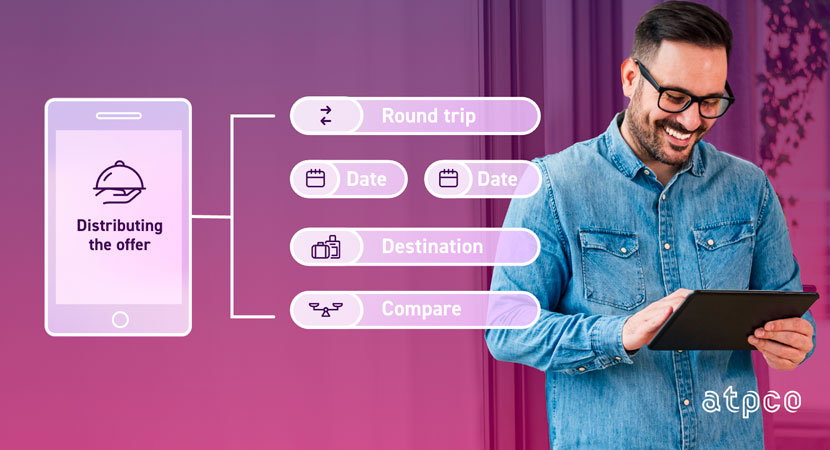
There is a lot of focus lately on the evolution of offer creation. Airline offer creation is a wildly complex topic that is being revolutionized by enhancements in pricing, merchandising, and modern retailing. After an airline creates an offer, the next step is to get that offer in front of flight shoppers so they can actually purchase it.
Distributing the offer has also gone through a metamorphosis, and it continues to be a foundational building block to offer creation. Advances in websites and APIs (Application Programing Interface) by the industry have dramatically changed an airline’s ability to get the right offer to the right customer at the right time and unlock true modern airline retailing, expanding the consumers' ability to search for offers from low fare and schedule search to shop by key attributes.
What does it mean to “Distribute the offer”?
Once an airline offer is created with all its relevant components, it needs to be distributed to flight shoppers so they can view, compare, understand, and purchase it. To make this happen, massive amounts of data flow back and forth from airlines to sellers to buyers and back again. This data movement from airline to buyer is airline distribution.
There are many formats and methods for sharing this data, some that have been around for a long time and have been the backbone of offers, such as a combination of fares, rules, fees, taxes, baggage, ancillaries, and brands files; schedule files; and availability files. For years, these data files have made it possible for third parties (like GDSs, global distribution system) to create and distribute offers on behalf of the airlines.
Over the last three decades, airline websites and, more recently, APIs (NDC) have enabled the shift of the creation of the offer from third parties back to the airline. While many still use the traditional three files for offer creation, this shift of creation back to the carrier lays the foundation for tremendous advances in how the airlines create offers. Today the traditional data powers between 70 and 80 percent of all offers sold in the industry, regardless of distribution method. API connectivity is growing but still represents less than 20 percent.
How these offers then get to consumers really depends on a combination of each airline’s preferences and business model as well as where consumers choose to shop. This balance will continue to evolve, and this process needs to be as efficient as possible while still making sure the data works properly everywhere it is used.
How does airline distribution work?
How do you book your flight? Do you go directly to your favorite airline and select the dates you need? Or maybe you browse through an online travel agency to see a list of all the flights and select the cheapest one? You might even opt to call a travel agent to just book everything for you. Regardless, flight shoppers have tons of different options for flights and other services, and airlines have just as many options to distribute them.
Airlines can distribute their offers by directly selling them on their website. They can also distribute their offers through global distribution systems (GDS). A GDS is a network system that enables transactions and connects the offer with an online travel agency or travel agents. As I mentioned earlier, by shifting the offer creation back to the airline, the airline is better equipped to respond to consumers’ needs and respond with more targeted offers because the airline has exclusive access to personalized data that the GDS doesn't, like frequent flyer preference. More and more airlines are choosing to distribute their offers directly to sellers using New Distribution Capability (NDC) in order to offer more personalization, more control over offers, and enable communications across the ecosystem.
How does ATPCO help Distribute the offer?
ATPCO facilitates the flow of air travel data across the entire airline ecosystem. ATPCO provides the first of the three big building blocks of offers: fare and rule data (the other building blocks are schedules, and availability). This data is foundational and is used across all distribution methods, including GDS, web, and API. We ensure that the data is consistent and operable in any system by managing standards that define each element and how it works with others.
ATPCO has set a corporate goal of getting the industry to 80 percent of offers sold in the market to be dynamic. The reason for this goal is that it has been shown that when the airline can construct the right offer and interact with the traveler at time of shopping, they can move to a modern retail experience which has been estimated to be worth USD 40 billion annually to the industry.
These standards are useful in more traditional distribution methods, but they also support newer ones like NDC. Even NDC offers created for direct channels must still interact with other industry systems such as servicing (changes and refunds) or travel agent commissions. And let's face it—NDC offers still need to be differentiated, to be revenue managed, to optimize the airline performance and the consumer experience— something that can be unlocked through robust data and standards.
ATPCO is taking steps to help all organizations within our industry ecosystem achieve its NDC goals:
- Supporting the expansion of NDC by leveraging existing infrastructure and sharing API technology to connect all content to all channels. The distribution shift is a slow evolution and airlines are working on both models. Leveraging the existing infrastructure will create interoperability and ease the transition.
- Through our NDC Solutions Design Team, working to define an actionable path for differentiating offers in NDC and to solve challenges relating to adoption and large-scale usage. There are many hurdles that still have not been solved for NDC. Some major ones ATPCO is helping solve are corporate and wholesale bookings and interline travel.
- Allowing access to the NDC Exchange technology and source code (it is available to the entire industry upon request). This is an effort to make the transition easier for airlines that have not yet started.
- Offering APIs for accurate, standardized data that can feed any system. Among this data are the elements that airlines need to merchandise their offer with marketing descriptions and pictures.
- Crafting an ATPCO standard—in our terminology an Appendix—to map ATPCO distributed offer creation elements to the respective IATA NDC standard, so that airlines know how to source data for their NDC offer messages.
From ATPCO to you, and between you and your partners, we make distribution easy. Airlines need data that works on every system, channel, and technology out there, and systems and channels need reliable data that they can trust—that is where we come in./ndc-solutions-source Regardless of how it is created or where its available, data is foundational to offers. Modern airline retailing requires ATPCO to support traditional and innovative distribution methods to provide the seller and traveler with more value than ever.
Let's talk solutions for offer distribution


